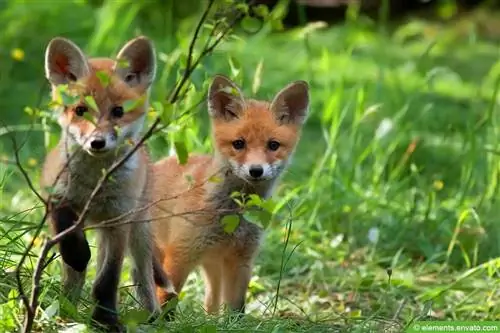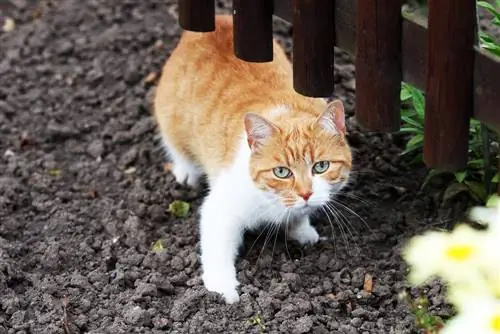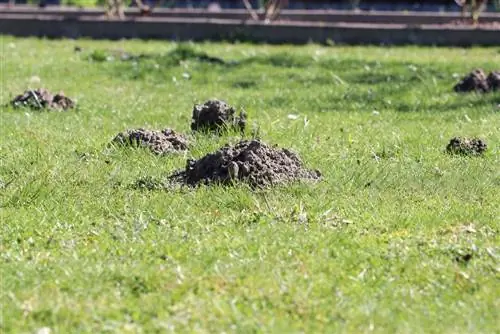- Author admin [email protected].
- Public 2023-12-17 03:39.
- Last modified 2025-06-01 06:48.
A fox in the garden is not always a welcome guest. We give you tips on how you can carefully keep wild animals away!
Why drive foxes out of the garden?
It is not uncommon for a fox to visit your home garden. The main reason for this is easily accessible food that he can find in vegetable patches or garbage cans. But as cute as he is, he is rarely wanted as a permanent guest in the garden. The shy wild animal is not really dangerous, but it can transmit diseases and cause damage to the garden. However, home gardeners can take certain measures to keep foxes out of gardens. But be careful: red foxes are protected in Germany, which is why the following should be noted:
- Foxes must not be captured
- They must not be harmed in any way
- Poisoning and killing is absolutely forbidden
- Putting a dog on a fox is not allowed
- Chasing away is okay - as long as the animals are not harmed
- Violations are punished with heavy fines and prison sentences
Note:
A live trap can be purchased commercially, but may only be set up by people who have a hunting license.
How to keep fox away?
To keep foxes out of gardens, you don't have to harm them. As a rule, it is sufficient to remove the causes of the game's visit. This primarily includes possible food sources, such as open garbage cans. It is also worth taking certain measures to make gardens as “uncomfortable” as possible for foxes so that they cannot find shelter.
Make food sources inaccessible
More and more foxes are roaming around the city and searching for food in gardens. This is usually successful because open garbage cans, but also all animal feed and cultivated fruit and vegetables serve as food sources for wild animals. One of the most effective measures to keep foxes out of gardens is to make any food sources inaccessible:
- Do not leave pet food lying around openly
- Set up bird food in a fox-proof manner - at least 1.5 meters high
- Always throw away leftover food
- Seal garbage cans well and replace them regularly
- Cover compost pile
- Removing fallen fruit from the ground
- Protect garden beds (e.g.: nets or fences)
Withdraw attractions
In local gardens, foxes not only find food, but also numerous attractions that keep them busy. Toys and garden utensils lying around also ensure fun and games for the wild animals. Cozy garden loungers invite you to linger and trampolines are often an exciting attraction for the animals. It can therefore be worthwhile to always put away small items and set up garden furniture so that they cannot be reached by foxes.

Insert scent notes
Preventative measures can be taken to prevent a fox from spreading around the garden in the first place - such as using scents. The shy wild animals have an aversion to human smells, which is why they are best suited for this purpose. There are special products commercially available (e.g.: Hukinol or Arcinol) that smell like human sweat and are therefore effective for keeping foxes away. Alternatively, sweaty clothing can also be used for this purpose. The procedure is very simple and is as follows:
- Leave fox droppings and spray with the product
- This will remove the fox's territory marking
- Soak the cloth in fragrance and hang it on a fence or wall
- Re-spray the cloth every few days
Note:
The fragrances mentioned smell very intense and can therefore cause an odor nuisance for neighbors. It is therefore advisable to discuss this measure with your neighbors in advance.
Light and water
Foxes are very shy and react fearfully to light, which is why outdoor lamps are ideal for keeping them out of the green area. Light sources have proven to be very useful for this purpose, especially in combination with a motion detector. But be careful: foxes are very clever creatures and can get used to the light if they notice that it poses no danger. As an alternative to light sources, there are also water sprinklers with motion detectors, which spray water in the direction of the animals when activated.
Sounds
Not only light but also noises have a deterrent effect on animals. These can be both human voices and music - such as from the radio. It may be worth simply leaving the radio on to keep wild animals out of the garden. Alternatively, there are special wildlife deterrent devices available from specialist retailers. These are equipped with a motion sensor and emit ultrasonic sounds in high frequencies (up to 65 kilohertz) that are not perceived by humans. To scare the animals away with noises, these tips are also worthwhile:
- Select radio stations with little music and a lot of spoken words
- Always vary so that animals don't get used to it
- Some game deterrents may vary rhythm
Protect small animals
Often some pets have an enclosure in the garden, such as rabbits, guinea pigs or chickens. It is important to protect these from foxes, otherwise they are easy prey for wild animals and therefore attract them. A secure enclosure not only protects pets, but can also help keep foxes out of the garden. The following features ensure that the enclosure is fox-proof:
- Dig fences about 50 cm deep into the ground
- Recommended height about 2 meters
- Bending fences outwards
- Set up a fox-proof stable as a retreat
What to do if fox is already in the garden?
If you catch a fox in the act, you can also scare it away with simple measures. Often it is enough to shout loudly to the animal, clap or jump. If you have a garden hose handy, you can spray it in the direction of the fox - alternatively, a bucket of water is also suitable. If you suspect that the animal is injured, a game warden should be informed.
Young Foxes

It is a special situation when a fox with young animals has nested in the garden. In this case, the garden owners are asked to be considerate, as otherwise the wild animals would leave their babies behind and they would hardly have a chance of survival. Instead of scaring away the fox family, you should let them stay (if possible) and keep the following in mind:
- Stay calm
- Don't get too close to the animals
- Don't try to pet the foxes
As soon as the young animals are old enough, the fox family will leave their shelter in the summer and the “fox hole” can be closed. Before doing so, however, you should make sure that all animals have actually left the burrow. To do this, it is worth sticking a small stick into the entrance hole and checking it in the following days. If it is still stuck vertically in the ground after several days, the cave is uninhabited and can be safely closed.
Tip:
Anyone who cannot offer the fox family shelter due to children or pets, for example, should inform the responsible forestry office or the nature conservation association.






